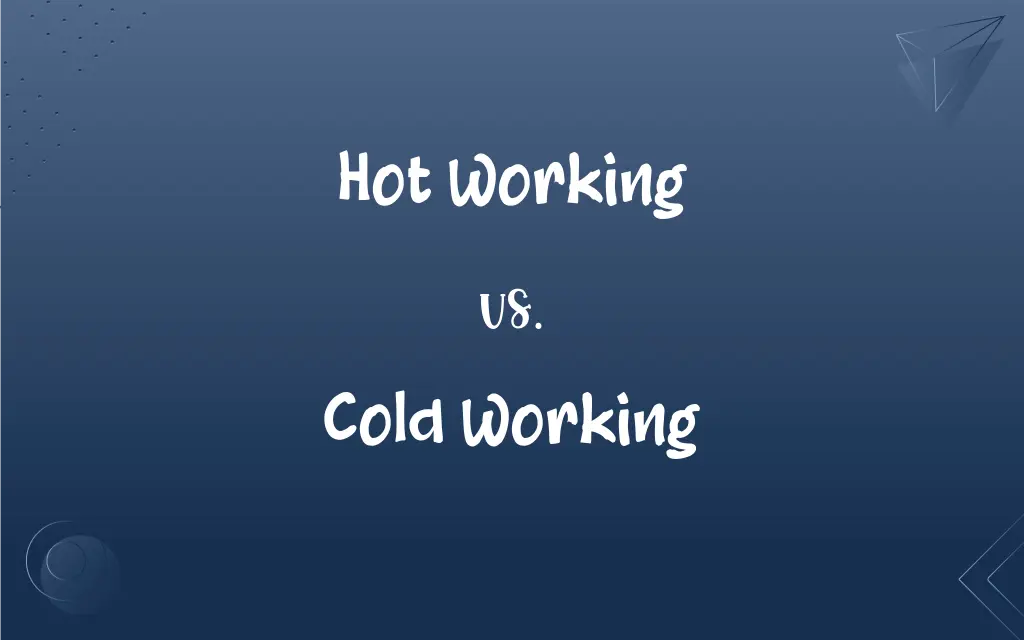Hot Working vs. Cold Working: What's the Difference?
Edited by Janet White || By Harlon Moss || Published on December 24, 2023
Hot working involves shaping materials at high temperatures above their recrystallization point, while cold working deforms materials at room temperature, strengthening them through strain hardening.

Key Differences
Hot working is a process where metals are deformed at temperatures higher than their recrystallization temperature, making them easier to shape and less likely to fracture. Cold working, in contrast, involves deforming metals at room temperature or below, which increases their strength and hardness due to strain hardening but also raises the risk of cracking.
During hot working, the grain structure of the metal can reform, leading to improved ductility and reduced residual stresses. Cold working, however, does not allow for this recrystallization, resulting in increased tensile strength but reduced plasticity and increased internal stress within the material.
Hot working processes, such as forging and hot rolling, typically require less force due to the decreased yield strength of the metal at high temperatures. Cold working methods like cold rolling and drawing, conversely, require greater force to shape the metal, as the absence of heating makes the material more resistant to deformation.
Metals processed through hot working often need subsequent finishing to achieve the desired surface quality, as the high temperatures can oxidize the material. Cold working, on the other hand, can produce a better surface finish initially, but the work hardening might necessitate additional heat treatments to relieve stresses.
Hot working is advantageous for large-scale deformations and is often more economical for large production runs. Cold working is suited for producing stronger, harder parts but may require more stages and treatments to achieve the final properties and dimensions.
ADVERTISEMENT
Comparison Chart
Temperature Range
Above recrystallization point
At or below room temperature
Material Properties
Increased ductility, decreased strength
Increased strength, decreased ductility
Process Force Required
Less force due to decreased yield strength
More force due to absence of heating
Surface Finish
Often requires finishing
Better initial surface finish
Application Suitability
Large-scale deformations, large runs
Producing stronger, harder parts
ADVERTISEMENT
Hot Working and Cold Working Definitions
Hot Working
Manufacturing process involving heating metals to facilitate shaping.
Hot extrusion of aluminum is carried out as a hot working process.
Cold Working
Manufacturing technique increasing metal's tensile strength.
Cold forging of bolts and screws is a typical cold working process.
Hot Working
Shaping materials at temperatures above their recrystallization point.
Forging steel at high temperatures is an example of hot working.
Cold Working
Process of shaping metals without heating, enhancing hardness.
Stamping metal parts in a press involves cold working.
Hot Working
Thermal treatment that allows metals to deform without fracturing.
Hot drawing of copper wires simplifies their shaping and elongation.
Cold Working
Metal deformation that induces strain hardening and residual stress.
Bending a metal rod at room temperature is an example of cold working.
Hot Working
Metalworking above the material's recrystallization temperature.
Making complex shapes in hot forging is an aspect of hot working.
Cold Working
Deforming metals at room temperature to increase strength.
Cold rolling of steel strips is a form of cold working.
Hot Working
The process of deforming metals in a pliable state due to heat.
Hot rolling of metal sheets is a common hot working technique.
Cold Working
Strengthening metals through strain hardening at low temperatures.
Wire drawing at room temperature represents cold working.
FAQs
What types of metals are suitable for hot working?
Metals like steel, aluminum, and copper are commonly hot worked.
Does hot working affect the chemical composition of the metal?
Generally no, but oxidation can occur on the metal's surface.
Is hot working more expensive than cold working?
It can be less expensive for large-scale production due to less force requirement.
Can hot working eliminate internal defects in metals?
Yes, it can help in refining the grain structure and removing porosity.
What are the key benefits of cold working?
It increases strength and hardness, with improved tolerances and surface finish.
Can cold working lead to metal fatigue?
Yes, due to the increased internal stresses and strain hardening.
Does cold working require more energy than hot working?
Yes, due to the increased resistance to deformation at lower temperatures.
Does hot working always require subsequent treatments?
Often it requires finishing treatments for surface quality improvement.
Can all metals undergo cold working?
Most ductile metals can, but brittleness can be a limiting factor for some.
Is cold working suitable for large-scale deformations?
It is less suitable for large deformations compared to hot working.
Can hot working processes alter the grain structure of the metal?
Yes, hot working can refine and homogenize the grain structure, improving the metal's overall properties.
Is there a risk of warping in hot working?
Yes, due to uneven cooling and heating, warping or distortion can occur in hot working.
How does the tool wear compare between hot and cold working?
Tool wear can be more significant in cold working due to the higher hardness and strength of the work material.
How does the speed of the process compare between hot and cold working?
Hot working can be faster due to metal's increased ductility at high temperatures, while cold working may be slower due to the need for higher precision and additional force.
Are there environmental considerations in choosing between hot and cold working?
Yes, hot working may require more energy for heating and can produce more emissions, while cold working is generally more energy-efficient.
How does the precision of the final product compare between hot and cold working?
Cold working generally allows for higher precision and tighter tolerances compared to hot working due to less thermal expansion and no grain growth.
Is annealing required after cold working?
Often, annealing or other heat treatments are necessary after cold working to relieve internal stresses and restore ductility.
Does hot working require specific cooling methods?
Controlled cooling is often necessary in hot working to ensure desired material properties and to prevent defects.
Is welding considered hot or cold working?
Welding is typically associated with hot working as it often involves melting and fusing materials at high temperatures.
Can cold working be combined with hot working in a manufacturing process?
Absolutely, many manufacturing processes use a combination of both to achieve desired material properties and shapes.
About Author
Written by
Harlon MossHarlon is a seasoned quality moderator and accomplished content writer for Difference Wiki. An alumnus of the prestigious University of California, he earned his degree in Computer Science. Leveraging his academic background, Harlon brings a meticulous and informed perspective to his work, ensuring content accuracy and excellence.
Edited by
Janet WhiteJanet White has been an esteemed writer and blogger for Difference Wiki. Holding a Master's degree in Science and Medical Journalism from the prestigious Boston University, she has consistently demonstrated her expertise and passion for her field. When she's not immersed in her work, Janet relishes her time exercising, delving into a good book, and cherishing moments with friends and family.






































































